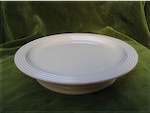|
In 1798, in the abandoned Carmelite convent in Longwy-Bas, Boch and Nothomb established a faience factory. This company has contributed to the reputation of the city of Longwy. Setting up the company was the final step of a long road. In the 18th century a veritable wave of faience factories moved from east to west from Lorraine, via Niderviller, Lunéville, Saint-Clément, Sarreguemines, Thionville, Islettes and Audun-le-Tiche. In some places these ventures did not last too long. However in Longwy the faience production thrived, has overcome crises and is still continuing after two centuries. |
||
|
Longwy has been know, in particular, for its émail cloisonné, which was introduced by Amédée de Caranza in 1875. With this technique he attempted to imitate the character of Persian objects. De Caranza later left to work with the competition in Bordeaux, which caused Longwy to be no longer the sole producer of this type of objects. |
Longwy cakestand. |
|
|
In the course of 200 years Longwy has produced a variety of faience. These objects, ranging from very modest to very prestigious, witness of the evolution of techniques, of taste, of society and of art. |
||




